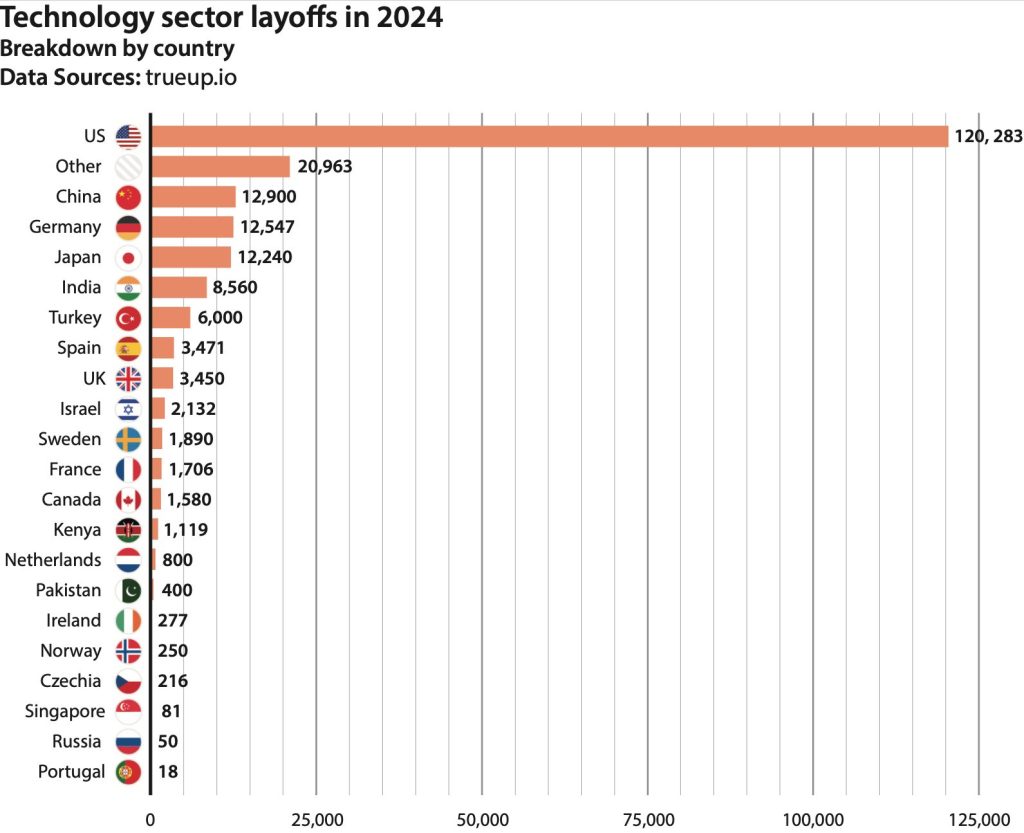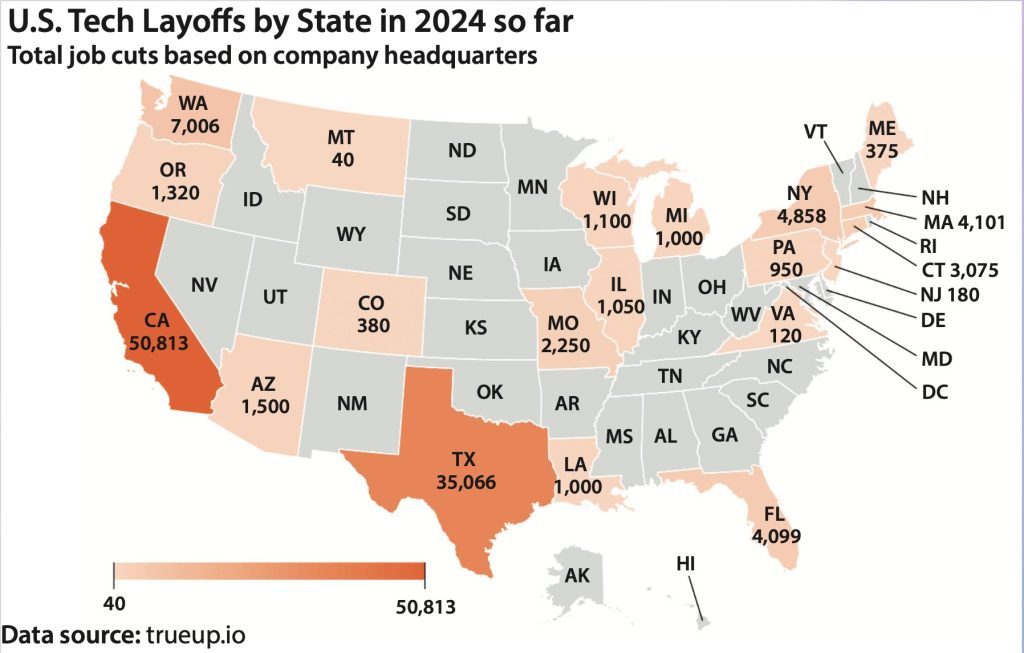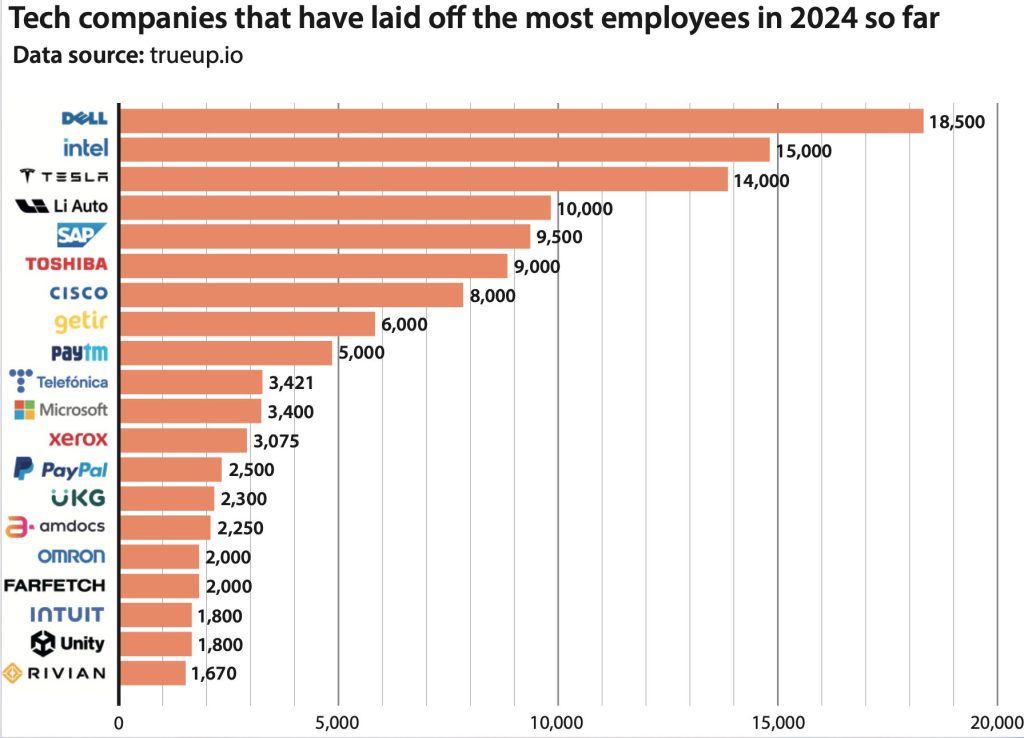September 24, 2024. Paul Hoffman
Last year, the tech industry faced a brutal wave of layoffs, with 167.6 thousand employees losing their jobs in the first three months alone, exceeding the total number of layoffs for all of 2022. This trend of job cuts has continued into 2024, driven by economic challenges, high interest rates, and rapid advancements in artificial intelligence, showing no signs of slowing down.
To illustrate the scale and distribution of global tech layoffs as of this year so far, the team at BestBrokers analysed over 800 layoff announcements from the technology sector tracked by the IT job portal trueup.io. We organised the layoffs in the database by company and country of headquarters, identifying the companies that have slashed the most jobs since January 2024.
Our findings reveal that a total of 211,033 employees have been laid off across more than 194 tech companies worldwide since the start of 2024, with firms such as Dell, Intel, and Tesla leading the cuts. While major tech players from countries like China (12,900 laid off employees), Germany (12,547 laid off employees), Japan (12,240 laid off employees), and India (8,560 laid off employees) have all made significant workforce reductions, U.S.-based corporations top this year’s layoff list with a staggering 120,283 job cuts, accounting for over half of the global total.
What’s driving tech’s massive layoffs?
Layoffs in the technology sector started as a consequence of over hiring during the COVID-19 pandemic. At first, companies rapidly expanded their workforces to meet the soaring demand for digital products and services. However, as the lockdown ended and demand for these products waned, many firms found they had more employees than needed, which led to significant job cuts. Last year alone, over 260,000 tech workers worldwide lost their jobs.
The rise in interest rates, which have made borrowing more expensive, only further exacerbated the situation. Companies have been forced to re-evaluate their strategies and cut costs, often through workforce reductions. Some experts predict that job losses in the U.S. may continue to escalate in the coming months as businesses struggle financially due to these high rates, potentially pushing the unemployment rate to five percent by the end of the year.
Moreover, advancements in automation and AI technologies have led to certain roles becoming redundant, prompting companies to restructure and downsize their teams accordingly. Tech firms, in particular, are heavily investing in AI, frequently at the expense of human jobs. Other factors contributing to the ongoing wave of tech layoffs include economic slowdowns, rising inflation, declining stock prices, slowing sales, and concerns about a potential recession.


California Firms Lead U.S. Tech Layoffs in 2024
In the U.S., California-based tech companies have taken the lead in layoffs this year, with a total of 50,813 job cuts, representing 42.24 percent of all job losses nationwide. The state’s high concentration of technology firms, especially in Silicon Valley, likely explains the substantial number of reductions. A big chunk of these cuts comes from chipmaker Intel, which alone has eliminated 15,000 jobs or 29.52 percent of the total job losses in California. Other significant reductions come from equipment manufacturer Cisco, which has shed 8,000 positions, and digital payment company PayPal, which has reduced its staff by 2,500 people.
Technology companies in Texas and Washington have also made significant workforce reductions, with a total of 35,066 and 7,006 employees affected, respectively. New York ranks high as well, with 4,858 jobs eliminated across eleven tech firms. Remarkably, even when combined, the cuts from the companies in these states do not exceed the total number of job losses reported by California-based companies alone. At the other end of the spectrum, firms in Montana and Virginia have announced the fewest reductions, with a combined total of just 160 job cuts since January 2024.
Companies with the biggest workforce reductions in 2024 so far
This year so far, major tech giants like Intel, Tesla, Microsoft, and Cisco have each laid off a significant number of employees, often citing restructuring and AI integration as key reasons. It’s Texas- based PC makerell, however, that stands out for cutting the most jobs across two rounds of layoffs.
After cutting 6,000 jobs earlier this year, Dell has now announced an additional reduction of approximately 10 percent of its workforce, or around 12,500 employees. This latest round of layoffs is part of a major reorganisation within the company, which includes establishing a new division focused on AI products and services. These cuts build on the previous fiscal year’s reductions, during which Dell eliminated 13,000 positions due to a slowdown in hardware sales, including personal computers.
After cutting 6,000 jobs earlier this year, Dell has now announced an additional reduction of approximately 10 percent of its workforce, or around 12,500 employees. This latest round of layoffs is part of a major reorganisation within the company, which includes establishing a new division focused on AI products and services. These cuts build on the previous fiscal year’s reductions, during which Dell eliminated 13,000 positions due to a slowdown in hardware sales, including personal computers.
China’s Li Auto also ranks high on the list, having reduced its workforce by 10,000 employees, which represents 77.52 percent of all job cuts made by Chinese companies since the beginning of the year. German software giant SAP has sacked around 9,500 positions as part of its 2024 restructuring plan, while Japan’s Toshiba has eliminated 9,000 roles. Other companies with significant workforce reductions include Getir, Paytm, Telefónica, Microsoft, and Xerox.
Methodology
For this report, the BestBrokers team analysed a total of 818 layoff announcements from the technology sector listed on the IT job portal trueup.io between January 1, 2024, and September 2, 2024. Layoffs were first aggregated by company to determine the total number of job cuts per firm. Companies were then categorised by their country of headquarters to illustrate the geographic distribution of these layoffs. Firms were ranked based on the size of their workforce reductions, identifying those with the largest cuts. Similarly, countries were ranked by the total number of layoffs reported by the companies based there.






